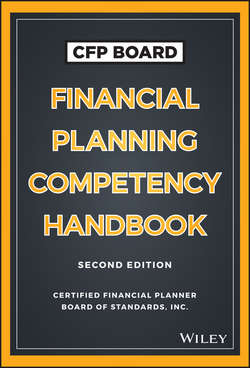Читать книгу CFP Board Financial Planning Competency Handbook - Board CFP - Страница 40
На сайте Литреса книга снята с продажи.
PART One
Introduction
CHAPTER 6
Financial Planning Process
INTRODUCTION
ОглавлениеThe process of financial planning is generally conceptualized as a six-step activity, as described by the Certified Financial Planner Board of Standards, Inc. (CFP Board):41
1. Establishing and Defining the Client–Planner Relationship: This first step in the financial planning process is important because it sets the stage for client–planner interactions by clarifying issues and concepts related to responsibilities of both parties in the relationship. CFP Board rules require financial planners to specify and document their services. CFP Board Practice Standard 100-1 further requires financial planners to specifically provide clients with the following information:42
■ Disclosures related to the practitioner’s material conflict(s) of interest.
■ Disclosures of a practitioner’s compensation arrangement(s).
■ Explicit disclosure of the client’s and the practitioner’s responsibilities.
■ Establishment of the duration of the engagement.
■ Any additional information necessary to define or limit the scope of the engagement.
2. Gathering Client Data, Including Goals: Gathering client data begins following the establishment of the client–planner relationship. According to CFP Board, data gathering includes interviewing or questioning clients about various aspects of their financial resources, obligations, and expectations. Data gathering also includes collecting all necessary documents necessary to perform analyses. This step in the process is most often used by financial planners to help their clients define and better understand financial goals and objectives, needs, desires, and priorities.
3. Analyzing and Evaluating the Client’s Financial Status: According to CFP Board, within the context of the financial planning process, examining and evaluating client data begins with a review of current cash flow needs. The analysis procedure continues with a review of risk management, investment, tax, retirement, employee benefits, estate planning, and special situation topics. Understanding a client’s values and attitudes, and determining the client’s time horizon, risk capacity, and risk tolerance, are important elements associated with this step in the planning process.
4. Developing and Presenting Financial Planning Recommendations and/or Alternatives: Financial planning recommendations should meet the unique goals and objectives of each client, reflecting his or her values, traditions, risk profile, and unique situation. Financial planners are expected to present, review, and discuss recommended strategies with clients to ensure that expectations and desired outcomes are maximized, and that recommendations are thoroughly understood by the client. It may be necessary to revise recommendations or alternatives based on client–planner discussions.
5. Implementing the Financial Planning Recommendations: Without client action to put recommendations into place, the likelihood that clients will reach their financial goals becomes uncertain. Clients and planners should agree on the steps necessary to move recommendations from theory into practice. During the implementation state of the planning process, financial planners will either carry out services for the client or counsel the client in coordinating efforts with other professionals. It is important for financial planners to use counseling and communication skills in this process.
6. Monitoring the Financial Planning Recommendations: Monitoring the soundness of implemented recommendations and progress toward goal achievement is a crucial aspect linked with the planning process. The client and planner must agree on who will monitor the financial progress. If it is the planner, then he or she should openly communicate with the client and make any necessary, ongoing adjustments to the plan relative to changes in the client’s life.
Financial planner and client situational factors play an important role in shaping applications of the financial planning process.43 Important financial planner situational factors include temperament, personality, attitudes, beliefs, behaviors, knowledge, and expertise. Client situational factors include risk tolerance, risk capacity, financial knowledge, personal/household characteristics, socioeconomic status, lifestyle, attitudes, beliefs, temperament, and personality. Planner and client situational factors combine to influence how goals are framed and how recommendations are formed in the areas of cash flow management, income tax planning, risk management, investment planning, retirement planning, education and special needs planning, and estate planning.
41
The financial planning process can be found under the Guide to CFP® Certification: www.cfp.net/become/experience.asp.
42
www.cfp.net/for-cfp-professionals/professional-standards-enforcement/standards-of-professional-conduct/financial-planning-practice-standards/practice-standards-100.
43
See Lytton et al., Process of Financial Planning, 159.
